I may get commissions for purchases made through links in this post.
Buddhist books for kids, really? Isn’t stuffing any religion or belief system down children’s throats a form of mental abuse? After all, they will have a hard time to be able to think freely ever after such indoctrination.
Yup, totally agree.
But there’s a difference between teaching kids about the history and basic principles of religions and doctrines and scaring, shaping, and manipulating them based on such belief systems.
Many great thinkers have said that it’s never a good thing to follow a set of somebody else’s rules.
“My technique is don’t believe anything. If you believe in something, you are automatically precluded from believing its opposite.” ― Terence McKenna
Nevertheless, dabbling into the tenets of Buddhism, more a philosophy than a religion, at a young age can be very beneficial.
The benefits of Buddhist books for kids
Taking note of Buddhism can learn children think for themselves, teach them about empathy and compassion. Which is needed since we, as a species, have some catching up to do.
Serious flaws in our education system result in basic skills not being learned. Admitted, a whole new approach in learning is currently being unfolded but much needs to be changed still.
Also parenting and human interaction could be improved upon. Thousands of years of the priniciple that humans are innately evil, of penance, of shame and guilt induction, of duty and obligations are hard to shake off.
Buddhist stories can help shift towards a more healthy, less violent culture. This may seem like a stretch but then maybe you do not realize our culture is completely permeated with violence (a striking example is our language).
Some more benefits:
- Buddhism can help develop compassion in a culture where violence is made enjoyable. Just think about the majority of movies and children’s cartoons in which the hero kills or beats someone up.
- A developed introspective look helps banish neuroticism and superstition. If you are able to feel what’s going on inside and outside, you are better capable of empathy.
- Empathy breaks down hierarchic structures and, more importantly, imagination requires empathy.
In his book The Empathic Civilization bestselling author Jeremy Rifkin points out that global empathy is essential in being able to cope with the great challenges of our time. A drastic change in human consciousness, the capacity and collective will to come together will be needed for our survival as a species.
“Imagination is more important than knowledge. For knowledge is limited to all we now know and understand, while imagination embraces the entire world, and all there ever will be to know and understand.” –Albert Einstein
Buddhism can be fun too
Enlightenment doesn’t require sitting under a tree for days. Nor does it call for being taught about or believing in Buddhism.
Just by amusing yourself and your offspring with the often both entertaining and meaningful Buddhist stories you may give them an edge in becoming generous, compassionate, virtuous, responsible, and self-reflecting beings.
These books may provide them with tools for learning what is really important in life and equip them with some basic skills needed to find happiness.
The 10 best books on Buddhism for children
If you want some assistance in choosing the right book for your little one, this list contains the most popular, highest rated, best selling books. It also explains why exactly these books are so great.
Through these books kids will learn the basics of Buddhism. The beautiful colorful illustrations, and vivid metaphors will also teach kids about relaxation, happiness, breathing, and even meditation.
They have shown to be entertaining for kids and adults parents alike. Many aren’t exclusively educative for kids, in fact they contain wonderful lessons for grown-ups as well. So beware, as a parent you might learn something new too.
#1 Buddha at Bedtime
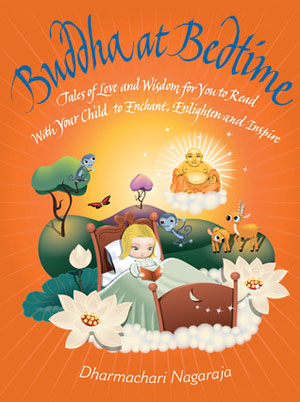
Buddhism made accessible and enjoyable for kids. This book is, in its kind, a jack of all trades. It includes 20, both short and long, stories about how to be wise and thoughtful. These stories are modern retellings of ancient Buddhist tales.
Buddha at Bedtime also offers an introduction to basic meditation and relaxation techniques, and demonstrates how to discuss the stories with the kids.
Furthermore there’s an overview of The Four Noble Truths, The Eightfold Path, and The Five Precepts.
Recommended for kids of ages 4-10.
Buddha at Bedtime: Tales of Love and Wisdom for You to Read with Your Child to Enchant, Enlighten and Inspire by Dharmachari Nagaraja.
#2 The Three Questions
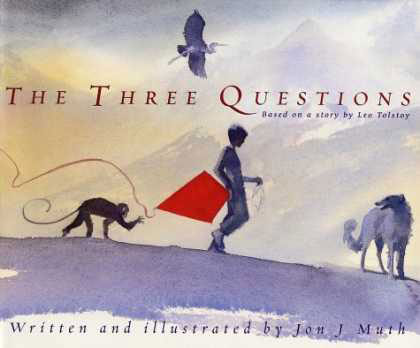 Based on the short story by Russian author Leo Tolstoy, The Three Questions is such a book that’s highly valued by both kids and parents as well. This story concerns a king who wants to find the answers to what he considers the three most important questions in life.
Based on the short story by Russian author Leo Tolstoy, The Three Questions is such a book that’s highly valued by both kids and parents as well. This story concerns a king who wants to find the answers to what he considers the three most important questions in life.
Jon J Muth’s The Three Questions teaches kids about compassion and living in the moment. The beautiful water-colored illustrations and the charming narrating style make this one of the best Buddhist books for kids.
Focused on kids aged 5 to 9 but readers from all ages might be able to satisfy their basic spiritual needs with it too.
This author’s children’s books have received numerous awards.
“The Three Questions is quietly life-changing” according to The New York Times Book Review. For curious parents, here’s the praiseful NY Times article.
”The Three Questions” presents a world of moral consequence and choice, where questions of right and wrong must be puzzled out and where each person’s actions really do make a difference. Young and old readers alike will take heart from that.”
#3 Peaceful Piggy Meditation
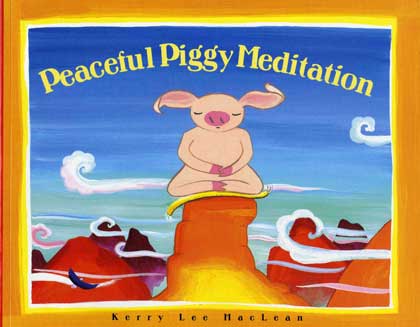 Simple meditation techniques for kids. Peaceful Piggy Meditation is a great book on itself but is also very useful as a tool to help restless, hyperactive kids find some inner peace.
Simple meditation techniques for kids. Peaceful Piggy Meditation is a great book on itself but is also very useful as a tool to help restless, hyperactive kids find some inner peace.
This book deserves to be in the top 10 because it is one of the few children’s books on Buddhism that explain and teach age-appropriate meditation techniques.
Despite it’s core topic being meditation the book has a down-to-earth, modern narrative style (e.g. there are video-game playing pigs). Reading this book at bedtime might help create an oasis of calmness and relaxation in a kid’s (and their parents) life.
“The book guides children through the reasons why meditation is necessary, and believe me when I say it is the best book on the market for doing so (I looked around extensively). Especially good is the “mind-in-a-jar” experiment at the end of the book which gives a concrete, hands-on demonstration of why meditation is necessary.” Amazon review
Peaceful Piggy Meditation (Albert Whitman Prairie Books)
#4 Zen Ties
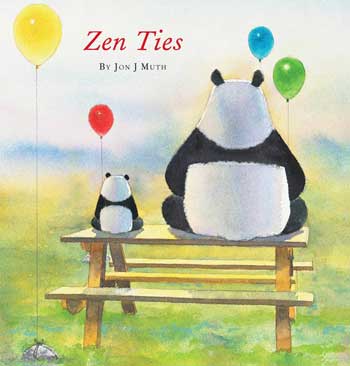 Probably the best kids book on Zen.
Probably the best kids book on Zen.
Zen Ties is another book of the hand of author and illustrator Jon Muth. In this particular book, Muth has done a great job in making Zen ideas and practices accessible to kids.
Themes of this book are; non-judgment, acceptance, friendship, forgiveness, connections, and community.
This is another example of a book written for kids that is capable of teaching adults some valuable life lessons too.
“He lovingly distills the wisdom of ancient Zen teachings into the most touching and practical stories about the things we all come up against in life and frequently do not, despite our best intentions, know how to handle.”
#5 Each Breath a Smile
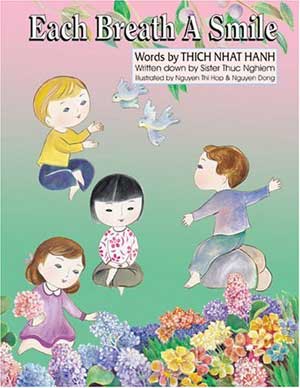 Great book on mindful breathing and a wonderful childrens book written by Sister Thuc Nghiem (Susan Swan), a grandmother, former teacher, and a nun in the tradition of Thich Nhat Hanh.
Great book on mindful breathing and a wonderful childrens book written by Sister Thuc Nghiem (Susan Swan), a grandmother, former teacher, and a nun in the tradition of Thich Nhat Hanh.
Each Breath a Smile shows kids how to relax and enjoy happiness through mindful breathing. This way they learn about Buddhism and how breathing the right way can help them experience calmness and joyfulness.
For preschool-aged kids.
Each Breath a Smile by Sister Susan. Plum Blossom Books.
#6 I Once Was a Monkey: Stories Buddha Told
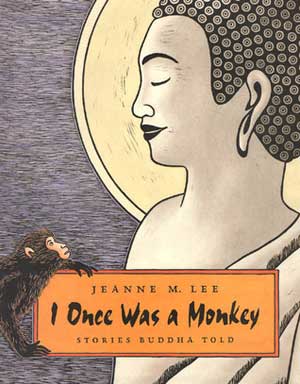 An introduction to Buddhism for kids.
An introduction to Buddhism for kids.
Another example of a book that does a great job at offering kids an introduction to Buddhism. The key themes of this book are; trust, telling the truth, friendship and kindness
I Once Was a Monkey: consists of short stories addressing universal values. These stories are based on so called jakatas.
Jakatas are tales that Buddha told. They are based on the experiences, and lessons that Buddha learned through his past lives as different animals. Buddha has been a monkey, dove, lion, jackal, and dove.
#7 Anh’s Anger
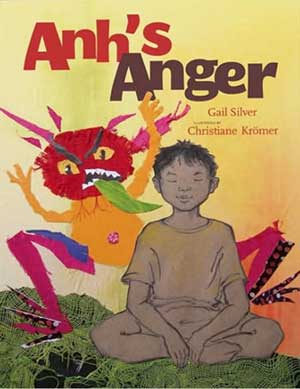 Anh’s Anger is another kids Buddhism book by Thich Nat Hahn. His typical sensitve and caring approach make this book about anger a true gem.
Anh’s Anger is another kids Buddhism book by Thich Nat Hahn. His typical sensitve and caring approach make this book about anger a true gem.
It teaches both kids and parents about the value of acknowledging and resolving complex emotions such as anger.
“A really simple and yet profound story of a grandfather teaching a young boy how to sit with the difficult emotion of anger. A lesson not just for children but grown ups as well.”
#8 A Pebble for Your Pocket
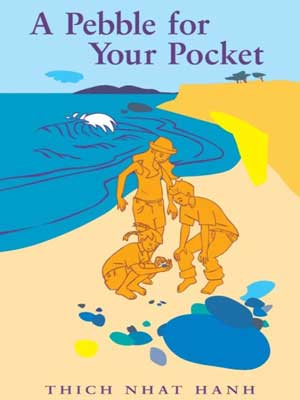 The author of this book is Thich Nhat Hanh , one of the most renowned Buddhist authors, Zen master, and Buddhist teacher. Core topics are living in the now, awareness, and spirituality in general.
The author of this book is Thich Nhat Hanh , one of the most renowned Buddhist authors, Zen master, and Buddhist teacher. Core topics are living in the now, awareness, and spirituality in general.
A Pebble for Your Pocket isn’t a picture book, so it’s probably best suitable for 8-12 year olds and kids that read independently.
Further on this page more on Thich Nhat Hanh and Buddhism books for kids from his hand.
“A Pebble for Your Pocket is a gem from a true spiritual master.” Parenting with Spirit magazine
#9 Parrot and the Fig Tree
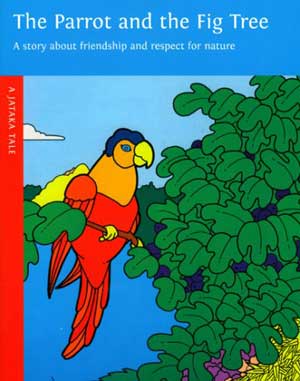 The Jataka Tales are a group of folk stories that originated in India, each of which relays an ethical teaching. Animals and magical beings, representing Buddha’s former lives, play an essential role in these tales.
The Jataka Tales are a group of folk stories that originated in India, each of which relays an ethical teaching. Animals and magical beings, representing Buddha’s former lives, play an essential role in these tales.
The tale of Parrot and the Fig Tree introduces seasons, the interdependency of all beings, and the value of loyalty.
A parrot refuses to abandon his good friend, a fig tree, even during winter when the tree has no figs, and eventually even when it is destroyed by a storm. For his loyalty to the tree, the parrot is rewarded by the god Shakra, with the rebirth of the tree.
This books also has coloring pages representing particular scenes from the story.
#10 Magic of Patience (A Jataka Tale)
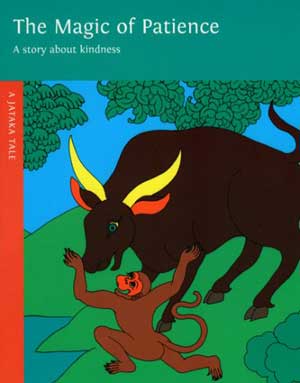 Buffalo persists in being kind and patient with the mischievous Monkey, despite all his annoying tricks.
Buffalo persists in being kind and patient with the mischievous Monkey, despite all his annoying tricks.
Core topic of this book is how to show patience, instead of anger, and how this behavior can yield goodwill and harmony.
Also with coloring pages.
Where to buy
For this complete list and some more Buddhist books for kids and teens head to Amazon .
.
I often have the tendency to frown when I hear ‘new age-y’ statements about how Buddhist stories can open the hearts and minds of people but If you think about it you’ll know it’s true.
Buddhism, offering its insightful look into human nature and motivations and all life around us is a great way for your offspring to inspire them to read and think deeper, search further, and explore their own as well as feelings of other living beings on our planet.
Featured image: Avtunkoni.


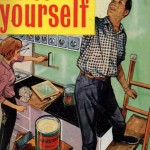





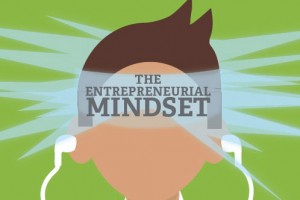













Really appreciate this annotated list. I agree that it’s not right to shove religion down a child’s throat. We don’t practice any religion in our house, but I do have a little book of Buddhist quotes that my 9-year-old son found and cherishes. He told that one of his goals for the summer is to read a book about Buddhism and learn to meditate. So in this case, it’s self-directed learning and I’m really glad to have this list.
Good to hear it’s appreciated Leah. I wish I had access to such books as a kid as I think of them as eye-opening. For me, Buddhism offers an antidote for the consumerist, ego-centered religion we’ve been fed from a young age.
Which book
Has the quotes? The name and author?
Over the years as a teacher of grades K-4, I have read all these books to my classes and they have become the children’s favorites as well as mine. One of my favorites in The Three Questions, which I read at the beginning of class and imprint these questions into the minds of the children as we do activities and read other books–it becomes the theme of every lesson.
A fun activity:
Have children break into groups and create tableau (still sculptures or photos) of a scene/scenes in the book that asks and/or answers these questions. Other groups watch the performing group and guess the scene and question.
Dana
I remember reading The Three Questions as if it were yesterday. One of the most profound short stories I have ever read as it really changed my way of thinking and acting. Thanks for sharing Dana.
Where can I buy
On Amazon. See the last section of this article for a direct link to the list.
It looks like a great list, but I wish you suggested a more ethical place to buy books from!
I am the author of a new book from Bala Kids an imprint of Shambahala Publicaitons, THE LIFE OF THE BUDDHA for children. It’s a very high quality book… I would be so honoured if you included it here as I think it would be a good fit with your excellent suggestions.